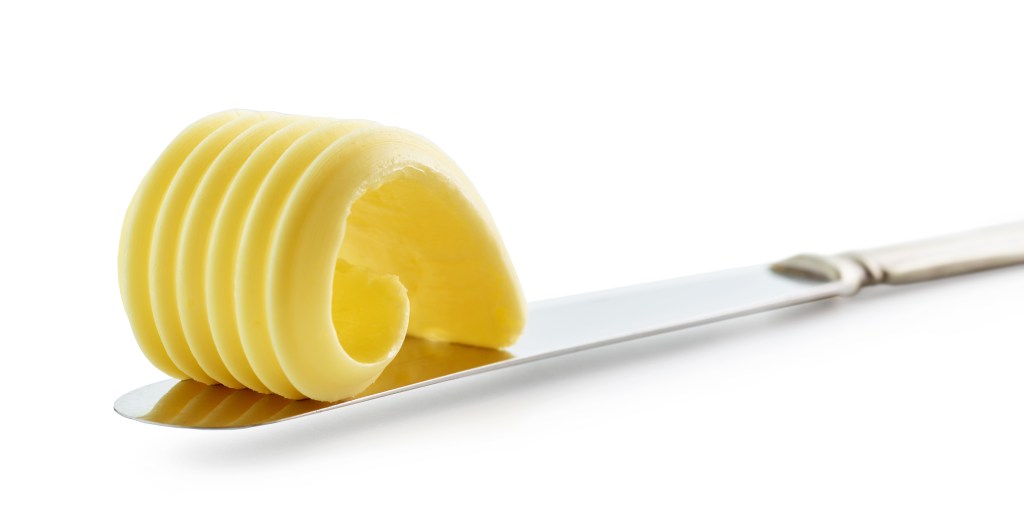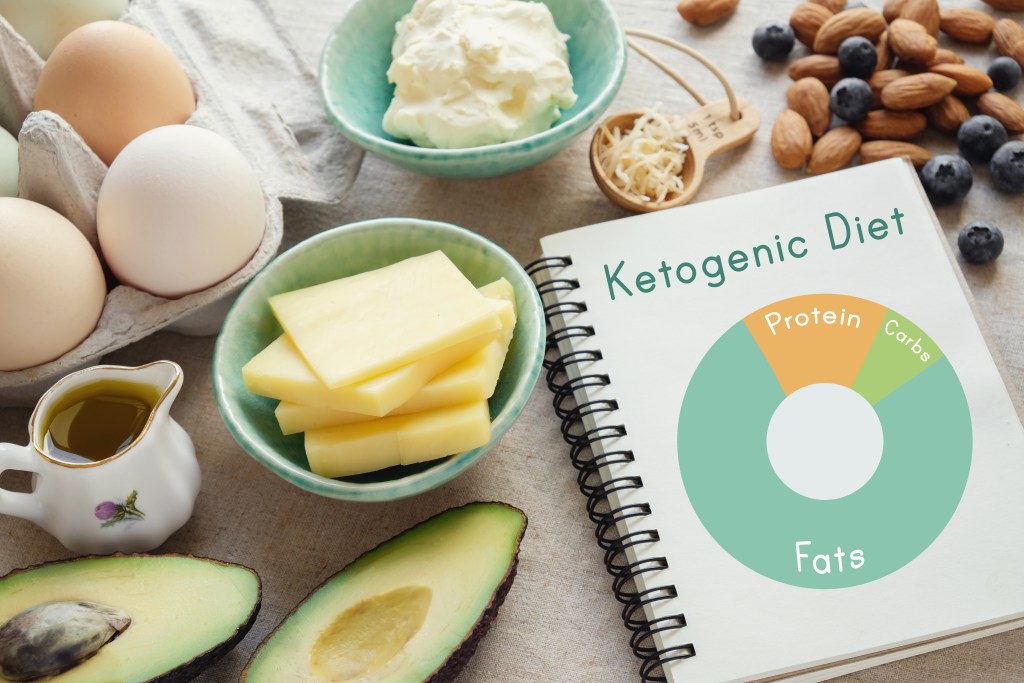At a glance
Butter is naturally carb-free and rich in healthy fats, making it an excellent choice for a keto diet. High-quality grass-fed butter provides essential fat-soluble vitamins and beneficial fatty acids that support metabolism and overall well-being.
Butter is rich in anti-inflammatory butyric acid, conjugated linoleic acid, and unsaturated fats, which are linked to various health benefits.
But is butter keto-friendly? Yes, butter contains no carbs and is safe to enjoy on a keto diet.
Learn why grass-fed butter is the best option for a nutritious ketogenic diet, and discover why eating butter won’t significantly raise your cholesterol levels.
How many carbs are in butter?
Butter is a staple in many keto meal prep routines and a perfect ingredient for a low-carb diet.
One tablespoon (14 grams) of butter contains around 0.02 grams of carbs, which isn’t enough to impact blood sugar or insulin levels.
However, it’s important to remember that some butter products may contain carbs.
While salted and unsalted butter is typically carb-free, flavored or sweetened butter spreads can contain up to ten carbs per tablespoon, which can be enough to kick you out of ketosis.
Always check the nutrition label for the carbohydrate content of the butter product you plan to use.
Watch the video below to discover the amazing benefits of eating butter on keto.
Is butter keto-friendly?
Yes, butter is keto-friendly and a perfect addition to a nutritious low-carb diet like Healthy Keto®.
It’s rich in health-promoting fats and a staple keto ingredient that’s ideal for pan-frying and sauteing vegetables. Butter works in a wide range of keto recipes, from Keto Buttercream Fat Bombs to Keto Garlic Lemon Butter Steak.
Butter is also essential for making keto butter coffee, known as Bulletproof coffee.
Drinking coffee mixed with butter and coconut oil–a rich source of medium-chain triglycerides–promotes ketosis and can help to extend fasting periods.
Butter and cholesterol on keto
You may have heard that consuming butter can raise cholesterol levels and increase the risk of heart disease. This is a common misconception.
Butter contains saturated fats, and it has previously been thought that this type of fat can elevate cholesterol.
However, a recent study published in Progress in Cardiovascular Disease has since refuted this claim and found that saturated fat intake doesn’t elevate low-density lipoprotein (LDL), the type of cholesterol associated with an increased risk of heart disease.1
In fact, the study found that high-carb diets, not saturated fatty acids, are linked to increased cholesterol production and cardiovascular disease, which explains why a ketogenic diet can lower cholesterol levels and promote heart health.
Consuming carbs and sugars stimulates enzymes in the liver to produce cholesterol, which can cause significantly elevated blood cholesterol levels. In contrast, fatty acids don’t stimulate hepatic cholesterol production.
What’s more, one tablespoon of butter contains around 30 milligrams of cholesterol, which is minimal compared to the 1500 milligrams of cholesterol produced in the liver daily.

Five benefits of butter on keto
Butter contains a complex mix of more than 400 fatty acids and phospholipids, including butyric acid and conjugated linoleic acid (CLA), two potent anti-inflammatory food compounds with impressive health benefits.
“Regularly consuming butter helps you lose weight, may lower your risk of colon cancer, and has been found to improve metabolic health and insulin sensitivity,” explains Dr. Berg.
Here are five reasons why you should eat butter on keto!
1. Nutritional powerhouse
Butter, especially grass-fed butter, is a rich source of several nutrients needed for cellular functions, energy production, growth and development, and hormonal balance.
Butter is an excellent source of:
- Vitamin A
- Vitamin E
- Vitamin K
- Beta-carotene
- Phosphorus
- Magnesium
- Potassium
- Calcium
- Conjugated linoleic acid
- Butyric acid
- Antioxidants
2. Promotes metabolic health
Butter can enhance the body’s ability to regulate blood sugar and insulin levels, a crucial aspect of metabolic health.
Both butyric acid and CLA have been found to promote insulin sensitivity, a measure of how well your cells respond to insulin. This can significantly lower the risk of insulin resistance, diabetes, metabolic syndrome, and fatty liver disease.
3. Aids weight loss
Butter is rich in healthy fats, promotes satiety, and may boost fat-burning, which explains why eating butter can make you thin.
CLA is needed to transport fats within the body and increases the activity of enzymes necessary to break down and utilize fats for energy production.
This fat-burning effect of CLA has been studied extensively, and research published in The Journal of Food Science found that “CLA may be effective at protecting against fat mass regain following weight loss.”2
4. May lower the risk of cancer
Evidence published in Agricultural and Biological Sciences suggests that eating butter may play a role in reducing the risk of colorectal cancer.3
Butyric acid in butter has been found to promote normal cellular function and may inhibit the growth of cancerous cells in the colon, which is linked to a lower risk of colon polyps associated with cancer development.
5. Natural antimicrobial
Butyric acid is an antimicrobial short-chain fatty acid that may be effective against bacterial strains linked to food poisoning and gastrointestinal infections such as E. Coli and Salmonella.
In addition, butyric acid is a fuel source for friendly gut bacteria, which promote balanced immune responses and lower the risk of intestinal health issues, including inflammatory bowel disease and small intestinal bacterial overgrowth (SIBO).

Best type of butter to have on keto
Grass-fed butter has more nutritional benefits than grain-fed butter and is an excellent choice for Healthy Keto.
Grass-fed cattle have access to pasture and forage on a natural diet of grasses and weeds, which results in butter that contains more nutrients such as beta-carotene and vitamin K and has more unsaturated fatty acids than conventional butter.
Grass-fed butter also contains omega-3 fats, making it a great alternative to salmon and mackerel for people who don’t like the taste of fatty fish.

How much butter can you have on keto?
Butter contains no carbs and won’t kick you out of ketosis. However, it’s an energy-dense food that’s high in calories, and eating too much butter can slow down your weight loss.
The liver utilizes dietary fats before breaking down stored body fat. Consuming large amounts of butter can shift your metabolism away from burning body fat as an energy source, which can hinder weight loss.
How much butter you can consume on keto also depends on your daily caloric needs and metabolic health.
One tablespoon of butter contains 14 grams of fat, which can be as much as ten percent of your daily fat requirements.
Key takeaways
- Butter is keto-friendly because it contains virtually no carbohydrates and supports ketosis through its rich fat profile.
- Grass-fed butter provides more omega-3s, vitamin K, and unsaturated fats than conventional butter, making it a more nutrient-dense option.
- Butyric acid and CLA in butter may help support insulin sensitivity, digestive health, and inflammatory balance.
- While butter supports ketosis, overeating it can cause the body to burn dietary fat instead of its own stored fat. Use moderate amounts to maintain optimal fat-burning.
FAQ
1. Is butter keto-friendly?
Yes, butter is carb-free and a rich source of healthy fats, making it an excellent choice for keto.
2. How much butter can I eat on keto?
Eating butter won’t kick you out of ketosis.
However, butter is energy-dense, and too much can slow weight loss. One tablespoon of butter contains 14 grams of fat, which can be as much as ten percent of your daily fat intake requirements.
3. Does butter contain too much cholesterol?
No, butter doesn’t contain too much cholesterol. One tablespoon of butter contains around 30 milligrams of cholesterol, a fraction of the 1500 milligrams of cholesterol produced by the liver daily.
4. What are the benefits of butter on keto?
Eating grass-fed butter boosts fat-soluble vitamins and may lower the risk of intestinal infections, insulin resistance, and metabolic syndrome.
In addition, butter is a rich source of conjugated linoleic acid (CLA), a type of fatty acid with potent anti-inflammatory properties that can benefit weight loss and overall health.
5. Can I have butter every day on keto?
Yes, butter is an everyday staple for ketogenic diets that you can safely consume daily.
However, it’s important to remember that butter is an energy-dense food, and excessive consumption may hinder weight loss or cause weight gain.
6. What kind of butter should I have on Healthy Keto?
Grass-fed butter is more nutritious than conventional grain-fed butter.
Grass-fed cattle graze on a natural diet of grass, weeds, and herbs, resulting in butter that contains higher amounts of fat-soluble vitamins, omega-3 fatty acids, and unsaturated fats.
7. Is salted or unsalted butter better on keto?
Both unsalted and salted butter can be suitable choices on a keto diet. However, unsalted butter may be a better option if you have low potassium or suffer from kidney issues.
8. Will butter cause weight gain on keto?
Eating moderate amounts of butter on keto won’t cause weight gain. However, one tablespoon of butter contains 14 grams of fat, and consuming too much can slow down weight loss or lead to weight gain.
9. Will one cheat day ruin ketosis?
Yes, one cheat day can disrupt ketosis, and it can take between 48 to 72 hours to switch back to fat-burning and ketone production after consuming high-carb foods.
10. Is clarified butter keto-friendly?
Yes, clarified butter, also known as ghee, is keto-friendly. Ghee is butter with milk solids removed, which makes it an excellent butter substitute for individuals with casein or lactose intolerance.
11. Is butter or olive oil better for keto?
Butter and olive oil are rich sources of health-promoting fatty acids, and it’s best to incorporate both types of fat into your keto diet plan.
Butter has a richer flavor and works great in baking, frying, and sautéing. In contrast, extra virgin olive oil is milder and perfect for dressings and dips.
12. Can I have buttered popcorn on keto?
Buttered popcorn contains a significant amount of carbohydrates and isn’t considered keto-friendly.
One cup of buttered popcorn has around 13 grams of carbs, which can quickly exceed your daily net carb count and interfere with ketosis.
Sources
- https://pubmed.ncbi.nlm.nih.gov/26586275/ ?
- https://ift.onlinelibrary.wiley.com/doi/epdf/10.1111/j.1750-3841.2007.00477.x ?
- https://www.sciencedirect.com/topics/nursing-and-health-professions/butyric-acid ?

















